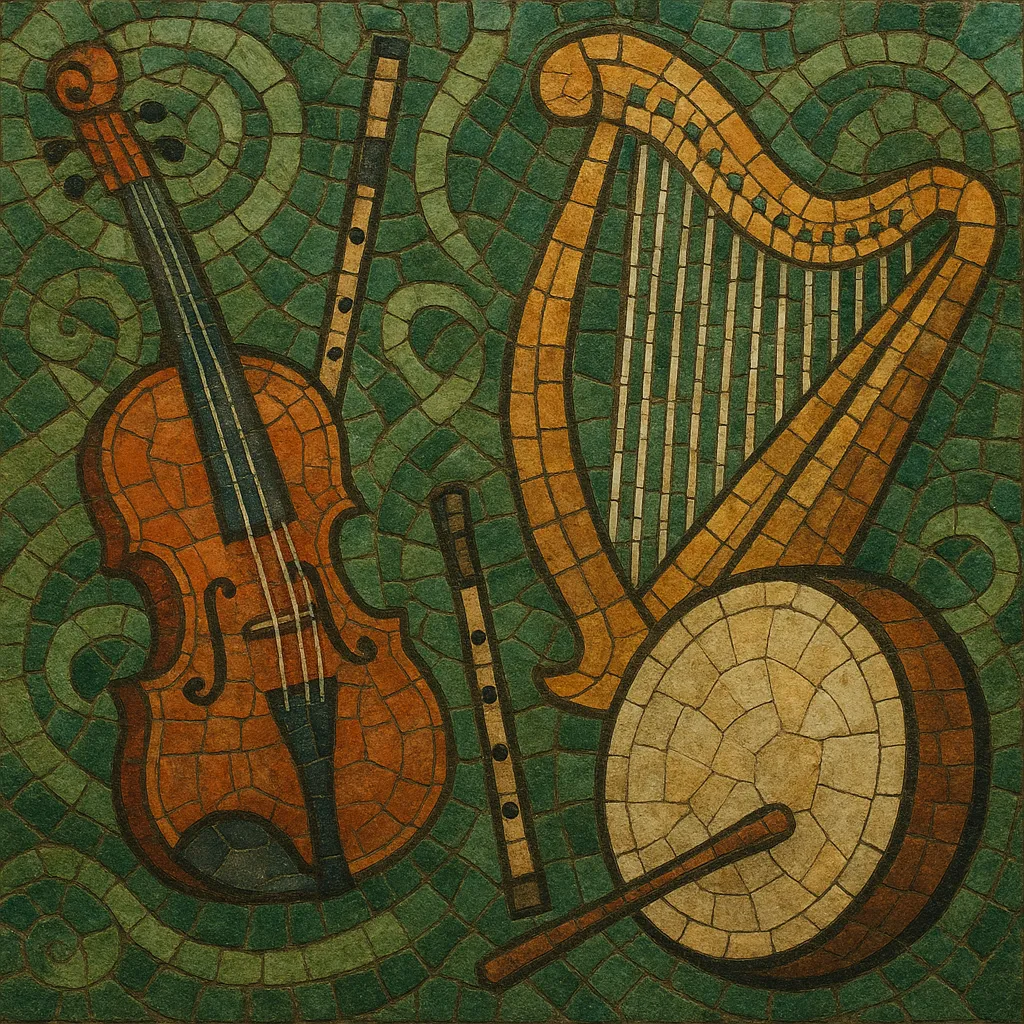Irish folk is the traditional song and dance-music heritage of Ireland, encompassing narrative ballads, unaccompanied sean-nós singing, and instrumental dance tunes such as reels, jigs, hornpipes, polkas, and slides.
Its sound is defined by modal melodies (often Dorian and Mixolydian), intricate ornamentation (cuts, rolls, triplets, and crans), and acoustic timbres from fiddle, uilleann pipes, tin whistle, wooden flute, harp, concertina/accordion, tenor banjo, bouzouki, guitar (often in DADGAD), and bodhrán. Performances commonly happen in informal “sessions,” where musicians share tune sets and variations, or on stage in folk ensembles.
Lyrically, the tradition ranges from humorous and convivial pub songs to poignant ballads of love, emigration, work, and resistance. The music’s social function—supporting dance, storytelling, and communal singing—remains central to its identity.
Irish folk draws on centuries of vernacular music-making, with strands of Gaelic song, narrative balladry, and dance tunes passed orally through rural communities. Unaccompanied sean-nós singing, with its free rhythm and melismatic ornamentation, represents one of the oldest stylistic pillars.
From the late 1700s through the 1800s, collectors and musicians began notating and publishing large tune repertoires (e.g., O’Farrell’s and later O’Neill’s collections), helping codify reels, jigs, hornpipes, and airs. Traditional music thrived at dances and local gatherings, while emigration spread Irish repertoire and style to Britain and North America.
A postwar folk revival brought Irish music to international stages. The Clancy Brothers and Tommy Makem popularized Irish ballads abroad; The Dubliners and The Chieftains helped establish ensemble formats that balanced authenticity with concert presentation. Groups like Planxty and The Bothy Band energized instrumental traditions with modern arrangements and virtuosity.
Irish folk fused with rock, punk, and pop (e.g., Celtic rock/punk) and influenced roots scenes worldwide. Bands such as Altan, Lúnasa, and De Dannan modernized ensemble craft while remaining tune-centric. The tradition remains community-based through sessions and céilithe, yet continues to innovate via new compositions, modal accompaniment (e.g., DADGAD guitar, Irish bouzouki), and hybrid projects with world and electronic music.
Despite stylistic evolution, core practices persist: tune sets for dance, song-led storytelling, modal approaches, and ornamented melodic variation. The music remains a living, communal art form closely tied to regional styles and the Irish diaspora.
Use acoustic, traditional timbres: fiddle, tin whistle, wooden flute, uilleann pipes, harp, concertina/accordion, tenor banjo, bouzouki, guitar (often in DADGAD), and bodhrán. Small ensembles (2–6 players) or session-style gatherings work well.
Write or select dance tunes in standard forms:
• Reels (4/4, driving, even subdivisions) • Double jigs (6/8) and slip jigs (9/8) with lilting accents • Hornpipes (4/4 with dotted swing; cadences often end on strong beats) • Polkas (2/4, brisk, especially in Sliabh Luachra regions) • Slides (12/8) and marches; for vocal pieces, compose airs in free or flexible rhythm.Arrange tunes into sets (e.g., reel–reel–reel) with smooth key/mode transitions.
Favor modal centers (Dorian, Mixolydian, Aeolian, and major). Keep harmony sparse: drones, open fifths, and simple vamps (I–VII or I–bVII) support the melody without overpowering it. DADGAD guitar and Irish bouzouki excel at modal, non-functional progressions and cross-string pedal tones.
Compose singable, motif-driven melodies. Add idiomatic ornaments: cuts and rolls on fiddle/whistle, crans on pipes, bowed triplets and slides on fiddle, grace-note clusters on flute/whistle. Encourage variation on repeats rather than jazz-style improvisation.
Use strophic ballad forms with refrains or call-and-response. Topics include love, emigration, work, history, and rebel narratives; pub songs can be humorous and communal. For sean-nós–inspired pieces, employ free rhythm, Irish language (optional), and highly ornamented melodic lines.
Maintain strong dance pulse even at moderate tempos. Interleave tune sets with ballads to balance energy. Let melody instruments trade leads; keep accompaniment light and percussive. Record naturally (minimal processing), prioritizing room sound and ensemble blend.
Capture transients and bow/breath detail with close miking plus room mics. Avoid heavy compression or dense chordal pads; clarity and interplay are essential.


